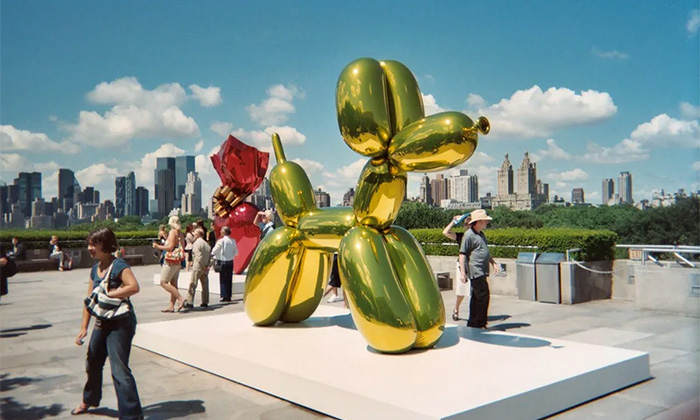 Aug 05, 2024
Aug 05, 2024
Jeff Koons is undoubtedly one of the most influential sculptors in the contemporary art world. His works are often controversial but also attract widespread attention. Among them, his series of giant "Balloon Dog" sculptures are arguably the most iconic.
Koons' Balloon Dog Sculpture made its first appearance in 1994 when he exhibited a giant Stainless Steel Balloon Dog at an outdoor show in New Jersey. Standing at 3.6 meters tall, this piece sparked an instant media frenzy due to its exaggerated and adorable design.
In 2013, Jeff Koons' Balloon Dog broke the record for the highest price ever paid for a work by a living artist, selling for $58.4 million. Born in 1955, Koons is renowned for his oversized reproductions of popular culture objects. Opinions about the artist vary: some view him as a trailblazer who will forever change art, while others criticize him for having low taste and being overly commercialized.
Balloon Dog and Celebration Series
Jeff Koons, "Celebration", 2013. Image source: Gagosian
Jeff Koons' Balloon Dog is part of his famous 1994 Celebration series, which consists of polished, shiny party items. The series includes about 20 large sculptures and around 15 paintings. Jeff Koons is very interested in nostalgic themes, showcasing inflatable animals, party favors, tulips, and even Easter eggs. His sculptures transport people back to the simple times of childhood and celebrate the joy of celebration through their immense scale.
The reasons why Jeff Koons' Balloon Dog sculpture is so eye-catching can be attributed to the following factors:
Exaggerated form with strong visual impact: Koons intentionally exaggerates and enlarges the shape of the dog, as if magnifying an ordinary rubber toy infinitely, creating a strong visual contrast.
Creative material selection: The use of industrial materials such as stainless steel and chrome gives the work a certain avant-garde futuristic feel.
Reflecting contemporary aesthetic tastes: By transforming a common children's toy like the balloon dog into an art piece, Koons hits on the contemporary society's aesthetic preference for simple and cute elements.
Provoking public attention and contemplation: Koons' works often spark controversy, but it is precisely this controversy that attracts widespread public attention, making them a focal point for discussions on contemporary art.
Koons describes himself as a "creative person". He first conceptualizes his works in the studio and then has others create them. Each of his sculptures is made of stainless steel, meticulously crafted, and coated with translucent layers of blue, magenta, orange, red, or yellow. These primary colors show that Koons is not afraid of the minimalist style characteristic of his artistic pieces.
The concept of reflection is at the core of Jeff Koons' inspiration and career. He explains that he has always been fascinated by light and the way it reflects on surfaces. He also states that he has been studying inflatables and reflective surfaces.
According to the artist, his biggest inspirations come from Salvador Dali and Andy Warhol. It is often said that Jeff Koons' work is close to Pop Art, an art movement that turns everyday items into provocative art. Koons was familiar with Salvador Dali's work from an early age and began emulating his approach to painting. Today, he is often compared to his contemporary, Damien Hirst.
While Jeff Koons has repeatedly stated that his works do not contain any hidden messages, many art critics have attempted to explain what makes this inflatable dog more profound than it appears. Weighing in at a ton, the dog is often said to play with the concept of heaviness and lightness. Objects that are typically fleeting become indestructible here. Koons' piece is a disposable toy, yet sturdy and magnificent.
Jeff Koons still provides an explanation: the theme of his inflatable sculptures is popular culture. These items are familiar to us, but placing them in an exhibition or museum setting can be unsettling. Koons also claims that his balloon dog symbolizes the human experience: just like these balloons, we inhale air. In other words, air is crucial to us, just like these balloons. One thing is certain, Jeff Koons likes his work to remain light and childlike.
Despite these works appearing childish, it's hard to ignore one fact: they are renowned for their high prices. Critics have been quick to express discontent when the simplicity and innocence of children's toys set sales records. In 2019, he even set a new record with his piece "Rabbit," sold for $91.1 million. Koons' silver inflatable rabbit thus replaced David Hockney's "Portrait of an Artist (Pool with Two Figures)."
Jeff Koons' name is often associated with the term "kitsch," a rather pejorative adjective referring to something that pretends to be art but lacks complexity or subtlety. Furthermore, his works are not made by himself, yet they can be sold at exorbitant prices, which is evidently controversial.
So the question arises, what makes a piece of art complex? How necessary is this standard for creating an engaging work? Where does the value of art lie: in the artist's passion or in the eyes of the public?
So, is it shallow art or an ode to simplicity? Is it unique creativity or a commercial gesture? Jeff Koons' colorful balloon dog might still be a point of contention in the years to come. And you, what are your thoughts on Koons' balloon dog?
